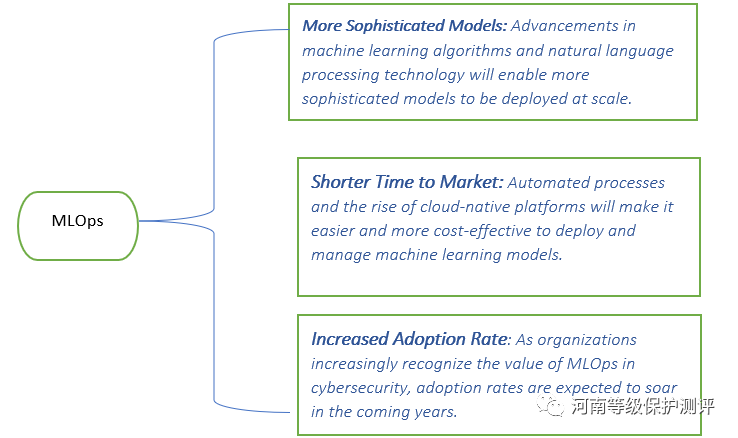
Machine Learning Operations (MLOps) refers to the practices and tools used to simplify the deployment, management, and monitoring of machine learning models in production environments.
While MLOps is typically associated with data science and machine learning workflows, its integration with cybersecurity brings new capabilities for detecting and responding to threats in real-time. It involves simplifying the deployment and management of machine learning models, enabling organizations to gain insights from large amounts of data and improve their overall security posture.

MLOps is a relatively new field that combines machine learning and software engineering. It focuses on developing and deploying machine learning services in a more efficient and automated way. This enables organizations to accelerate the use of machine learning in their security programs, improve detection and response times, and ultimately reduce risk.
MLOps requires collaboration between data scientists, developers, and operations teams. Together they manage the entire machine learning lifecycle from data preparation to model deployment.
Automation is the core of MLOps. By automating model training, deployment, and management, organizations can deploy models faster and reduce errors
MLOps helps organizations scale machine learning across multiple teams and projects application, making it easier to manage and maintain machine learning models
MLOps enables organizations to run faster and more efficiently than ever Accurately detect and respond to threats, potentially changing the game for cybersecurity. Machine learning models can help organizations detect and respond to cyber threats faster and more accurately than traditional methods. Additionally, MLOps tools can help organizations manage and maintain machine learning models at scale, thereby improving their overall security posture.
There are several benefits of using MLOps in cybersecurity:
Here are some real-world examples:
While MLOps has many benefits, there are still many challenges that need to be faced when integrating it into an organization’s cybersecurity practices Challenges:
The role of MLOps in cybersecurity will continue to grow in the coming years. As machine learning technology advances and organizations become more data-driven, MLOps is expected to become an important part of every organization’s cybersecurity toolkit.

In the real world of cybersecurity, MLOps are expected to evolve as new concepts and methodologies are developed to enhance threat detection, Incident response and overall security operations. Here are some future MLOps concepts specific to cybersecurity
The future of MLOps concepts will focus on developing adaptive and self-learning security systems to cope with constant changes threats. These systems will leverage continuous learning technology to update their models in real time based on new threat intelligence and attack patterns to proactively defend and quickly respond to emerging cyber threats
rewritten What: Zero-day threats are vulnerabilities or attack vectors unknown to the security community. Future MLOps concepts will explore advanced machine learning algorithms and techniques to detect and mitigate zero-day threats. By analyzing network traffic, system behavior and anomaly detection, machine learning models can identify unknown patterns and suspicious activity associated with zero-day attacks
MLOps will continue to improve and advance behavior-based anomaly detection technology. Machine learning models will be trained to understand normal patterns of user and system behavior and identify deviations that may indicate malicious activity. These models will be integrated into security systems to provide real-time alerts and responses to anomalous behavior.
MLOps will leverage advanced threat hunting technology to proactively search for potential threats and vulnerabilities within an organization’s networks and systems. Machine learning models will analyze large amounts of data, including log files, network traffic, and threat intelligence feeds, to identify hidden threats, suspicious activity, and potential attack vectors.
MLOps will focus on enhancing the capabilities of threat intelligence analysis by leveraging machine learning models. These models will process and analyze real-time threat intelligence data from a variety of sources, including open source intelligence, dark web surveillance, and security sources. By integrating these models into security systems, organizations can more effectively identify and respond to emerging threats.
Future concepts for MLOps will focus on developing adaptive and resilient defense mechanisms that can dynamically adjust security controls based on real-time threat intelligence. Machine learning models will continuously monitor and analyze security events, system vulnerabilities and attack patterns to optimize security configurations, deploy policies and respond to threats in real time
UEBA systems leverage machine learning models to detect and respond to anomalous user and entity behavior that may indicate insider threats or account compromise. Future MLOps concepts will focus on improving the accuracy and effectiveness of UEBA systems through advanced machine learning algorithms, improved feature engineering, and integration with other security systems to enable comprehensive threat detection and response
These future concepts in cybersecurity within MLOps are designed to strengthen defenses against complex and ever-changing cyber threats, enabling organizations to detect, respond, and mitigate security incidents in a more proactive and efficient manner.
MLOps is a powerful framework that can significantly enhance cybersecurity defenses. By leveraging the power of machine learning models, organizations can improve threat detection, real-time monitoring, malware analysis, and user behavior analysis. MLOps enable security teams to respond quickly to emerging threats, reduce the likelihood of data breaches and minimize the impact of cyberattacks.
As the cybersecurity landscape continues to evolve, the integration of MLOps will play a vital role in protecting our digital ecosystem.
The above is the detailed content of Cybersecurity will be revolutionized by machine learning operations. For more information, please follow other related articles on the PHP Chinese website!
 What to do if win8wifi connection is not available
What to do if win8wifi connection is not available
 Comparative analysis of iqooneo8 and iqooneo9
Comparative analysis of iqooneo8 and iqooneo9
 How to use fit function in Python
How to use fit function in Python
 Solid state drive data recovery
Solid state drive data recovery
 Change word background color to white
Change word background color to white
 Google earth cannot connect to the server solution
Google earth cannot connect to the server solution
 What are the reasons why a mobile phone has an empty number?
What are the reasons why a mobile phone has an empty number?
 css beyond display...
css beyond display...




